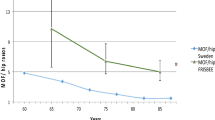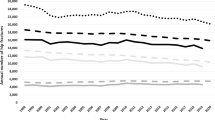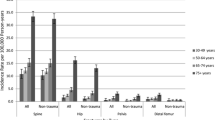Abstract
To test the hypothesis that osteoporosis, which results partly from long-term estrogen deficiency, is associated with a lowered risk of breast and endometrial cancer, a population-based cohort study was performed in Sweden. Some 18,000 women were followed through record-linkages after a first hip fracture, on average for almost six years, to ascertain the incidence of breast and endometrial cancer. Expected numbers were derived from the general population. Overall, 253 cases of breast cancer were observedcf 300 expected (standardized incidence ratio [SIR]=0.84; 95 percent confidence interval [CI]=0.74–0.95). Forty-eight cases of endometrial cancer were foundcf 55 expected (SIR=0.87, CI=0.54–1.16). There was no clearcut pattern of breast cancer risk by age at diagnosis of hip fracture, follow-up time, or calendar period. Our results are consistent with thea priori hypothesis that long-term estrogen deficiency is associated with a reduced risk of developing breast cancer as well as endometrial cancer.
Similar content being viewed by others
References
Adami HO, Adams G, Boyle P et al., Breast cancer etiology. Report from a working party for the Nordic Cancer Union Meeting 1989.Int J Cancer 1990; suppl 5:22–39.
Kelsey JL, Gammon MD. Epidemiology of breast cancer.Epidemiol Rev 1990;12:228–40.
Boyle P. Epidemiology of breast cancer.Baillière's Clin Oncol 1988;2: 1–59.
Brinton LA, Schairer C, Hoover RN, Fraumeni JF Jr. Menstrual factors and risk of breast cancer.Cancer Invest 1988;6:245–54.
MacMahon B, Cole P, Lin TM, et al. Age at first birth and cancer of the breast. A summary of an international study.Bulletin of the WHO 1970;43:209–21.
Henderson BE, Ross RK, Judd HL Krailo MD, Pike MC. Do regular ovulatory cycles increase breast-cancer risk?Cancer 1985;56:1206–8.
Rose DP. Dietary factors and breast cancer.Cancer Surv 1986;5:671–82.
UK Natinal Case Control Study Group. Oral contraceptive use and breast cancer risk in young women.Lancet 1989;i:973–82.
Steinberg KK, Thacker SB, Smith SJ, et al. A meta-analysis of the effect of estrogen replacement therapy on the risk of breast cancer.JAMA 1991;265:1985–90.
De Waard F, Trichopoulos D. A unifying concept of the aetiology of breast cancer.Int J Cancer 1988;41:666–9
Key TJA, Pike MC. The role of oestrogens and progestogens in the epidemiology and prevention of breast cancer.Eur J Cancer Clin Oncol 1988;24:29–43.
Parazzini F, La Vecchia C, Bocciolone L, Francheschi S. The epidemiology of endometrial cancer.Gynecol Oncol 1991;41:1–16.
Herrington LJ, Weiss NS. Postmenopausal unopposed estrogens characteristics of use in relation to the risk of endometrial carcinoma.Ann Epidemiol 1993;3:308–18.
Whitehead MI, Townsend PT, Pryse-Davies J, Ryder TA, King RJB. Effects of estrogens and progestins on the biochemistry and morphology of the post-menopausal endometrium.N Engl J Med 1981;301:1599–605.
Cummings SR, Kelsy JL, Nevitt MC, O'Dowd KJ. Epidemiology of osteoporosis and osteoporotic fractures.Epidemiol Rev 1985;7:178–208.
Drinkwater BL, Nilson K, Chesnut CH, et al. Bone mineral content of amenorrheic and eumenorrheic athletes.N Engl J Med 1984;311:277–81.
Genant HK, Cann CE, Ettinger B, Gordon GS. Quantitative computed tomography of vertebral spongiosa: A sensitive method for detecting early bone loss after oophorectomy.Ann Intern Med 1982;97:699–705.
Adami HO, Zack M, Kressner U, et al. No protection against hip fractures in women with breast cancer. Evidence from a population-based cohort study.Am J Epidemiol 1990;132:877–83.
Persson I, Naessén T, Adami HO, et al. Reduced risk of hip fracture in women with endometrial cancer.Int J Epidemiol 1992;21: 638–42.
National Board of Health and Welfare.In-patient Statistics from Hospitals for Physical Diseases in the Uppsala Region. Stockholm, Sweden: National Board of Health and Welfare, 1969;Patient Statistics No. 1.
Naessén T, Parker R, Persson I, et al. Time trends in incidence rates of first hip fracture in the Uppsala Health Care Region, Sweden, 1965–1983.Am J Epidemiol 1989;130:289–99.
Population Unit.Total Population Register. Örebro, Sweden: Statistics Sweden, 1993.
The Cancer Registry,Cancer Incidence in Sweden 1987. Stockholm, Sweden.: National Board of Health and Welfare, 1992.
World Health Organization.International Classification of Diseases. Seventh Revision Geneva, Switzerland: WHO, 1957.
World Health Organization.International Classification of Diseases. Eighth Revision. Geneva, Switzerland: WHO, 1967.
Official Statistics of Sweden.Causes of Death 1988. Stockholm, Sweden: National Bureau of Statistics, 1991.
Johnell O, Sernbo I. Health status in patients with hip fractures and controls.Age Ageing 1986;15: 285–91.
Magaziner J, Simonsick EM, Kashner TM, Hebel JR, Kenzora JE. Survival experience of aged hip fracture patients.AJPH 1989;79:274–8.
Cummings SR, Kelsey JL, Nevitt MC, O'Dowd KJ. Epidemiology of osteoporosis and osteoporotic fractures.Epidemiol Rev 1985;7:178–208.
Winner SJ, Morgan CA, Grimley Evans J. Perimenopausal risk of falling and incidence of distal forearm fracture.Br Med J 1989;298:1486–88.
Melton LJ, Kan SH, Frye MA, et al. Epidemiology of vertebral fractures in women.Am J Epidemiol 1989;129 100–11.
Christiansen C, Christiansen MS, McNair P, et al. Prevention of early post-menopausal bone loss: controlled 2-year study in 315 normal females.Eur J Clin Invest 1980;10:273–9.
Naessén T, Persson I, Ljunghall S, Bergström R. Women with climacteric symptoms: A target group for prevention of rapid bone loss and osteoporosis.Osteoporosis Int 1992;2:225–31.
Hutchinson TA, Polansky SM, Feinstein AR. Postmenopausal oestrogens protect against fractures of hip and distal radius: a case-control study.Lancet 1979,ii: 705–9.
Kreiger N, Kelsey JL, Holford TR, O'Connor T. Anepidemiologic study of hip fracture in postmenopausal women.Am J Epidemiol 1982;116:141–8.
Paganini-Hill A, Ross RK, Gerkins VR, et al. Menopausal estrogen therapy and hip fractures.Ann Intern Med 1981;95:28–31.
Weiss NS, Ure CL, Ballard JH, Williams AR, Daling JR. Decreased risk of fractures of the hip and lower forearm with postmenopausal use of estrogen.N Engl J Med 1980;303:1195–8.
Kiel DP, Feison DT, Anderson JJ, Wilson PWF, Moskowitz MA. Hip fracture and the use of estrogens in postmenopausal women. The Framingham study.N Engl J Med 1987;317:1169–74.
Ettinger B, Genant HK, Cann CE. Long-term estrogen replacement therapy prevents bone loss and fractures.Ann Intern Med 1985;102:319–24.
Naessén T, Persson I, Adami HO, Bergström, R, Bergkvist L. Hormonal replacement therapy and the risk for first hip fracture. A prospective, population-based cohort study.Ann Intern Med 1990;113:95–103.
Baron JA, La Vecchia C, Levi F. The antiestrogenic effect of cigarette smoking in women.Am J Obstet Gynecol 1990;162:502–14.
Pritchard DJ, Burch PA. Orthopedic complications. In: Holland JF, et al., eds.Cancer, Medicine, 3rd edition Philadelphia, PA (US): Lea & Febiger, 1993: 2290–3.
Krane SM, Holich MF. Metabolic bone disease. In: Wilson JD, ed.Harrison's Principles of Internal Medicine, 12th ed. New York, NY (US) McGraw-Hill, Inc, 1991; 1921–32.
Author information
Authors and Affiliations
Rights and permissions
About this article
Cite this article
Persson, I., Adami, HO., McLaughlin, J.K. et al. Reduced risk of breast and endometrial cancer among women with hip fractures (Sweden). Cancer Causes Control 5, 523–528 (1994). https://doi.org/10.1007/BF01831380
Received:
Accepted:
Issue Date:
DOI: https://doi.org/10.1007/BF01831380




